Not a good look? or: Why women might dress as Thorin Oakenshield
First, a surely incomplete collection of Richard Armitage’s statements and responses around the topic of dwarvish secondary sex characteristics, women dressing as Thorin, the possibility of an Armitage Army uniform that involved beards, and encountering female fans cosplaying Thorin at premieres.
***
Richard Armitage, asked about the apparent lack of female dwarves in The Hobbit: An Unexpected Journey, interviewed on Canada AM, December 3, 2012:
***
Richard Armitage with Hobbit cosplayers, November 4, 2013, New York City, where he was described as complimenting Thorin’s cosplay. I’m not sure if I ever saw an account from the Thorin cosplayer. Source: WritingHaven
***
Richard Armitage responds to Evangeline Lilly’s statement about the crossover between LOTR and Lost fans, Cinemax Final Cut interview, recorded December 3rd, 2013.
***
Richard Armitage, interviewed by Access Hollywood on fan enthusiasm, posted December 5th, 2013 (full interview here):
“I guess the Armitage Army should find themselves a uniform … um …”
“Do you have any suggestions?”
“Something military.”
“OK.”
“Maybe some dwarvish armor.”
“Right, right. Like wristbands or something?”
“Something a bit … wigs and be– maybe they should wear beards.”
“Braids?”
“Beards.”
“OK. I’m glad we got that clarified.”
***
Richard Armitage and fan, Los Angeles premiere of The Hobbit: The Desolation of Smaug, December 2, 2103. Source: Mostly Richard.
****
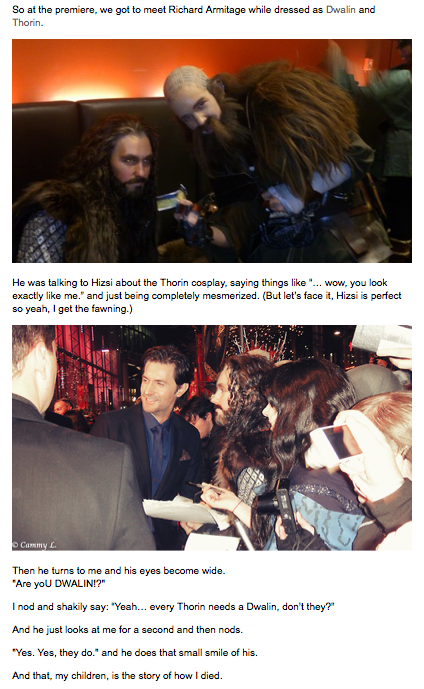 Richard Armitage encounters cosplaying fans at the Berlin premiere of The Hobbit: The Desolation of Smaug, December 9, 2013. Source: Märchenstunde
Richard Armitage encounters cosplaying fans at the Berlin premiere of The Hobbit: The Desolation of Smaug, December 9, 2013. Source: Märchenstunde
***
[Pictures of fans cosplaying Thorin below are taken from here, a collection of Thorin entries in the contest for a ticket to the Hobbit fan event in New York City, November 4, 2013.]
I put all that stuff up because I wanted to make sure everyone knew, and everyone knew that I know, that Richard Armitage’s visible-to-us reactions to the gender issues involved in women dressing up as Thorin Oakenshield are varied, multi-layered, complex. They include elements that respond to the venues in which questions are asked. The Cinemax interview format is supposed to be “rawer”; he’s always polite to fans when he meets them. Additionally, no doubt, elements of his own reactions are present, as processed through his particular sense of humor and mechanisms for dealing with the press. What came out included both respect for cosplaying fans and delight at their energy and imagination as well as apparent surprise or wry / dry amusement or disbelief that women would cosplay Thorin. He has both joked tongue-in-cheek about the potential stylishness of female beards and responded in a slightly negative way to to the potential attractiveness of “bearded” women. And he’s made what reads to me as a delightfully facetious suggestion that Armitage Army members could wear beards to identify themselves — a possibility he apparently finds funnier than some of his fans have.
***
***
But the Cinemax interview raised a question for me that’s germane to Armitage’s broader appeal to female audiences, a matter that’s come up here and there over the years. Why is it that Armitage’s fan base is so heavily skewed toward women? Why does a certain kind of woman fall for Armitage? Many answers can be offered to that question and this post doesn’t seek to mention, let alone plumb, them all. Obviously, his pronounced talent and physical beauty both play a role in his appeal. I could also list his breakthrough in North & South as a costume drama hero with all sorts of traditional appeal to female readers; his tendency to play heroes or very sympathetic anti-heroes; and so on. I have other answers I’ll explore more fully as I keep writing, one of which relates to the regular involvement of his characters in status games and gender trouble.
Where I want to go here, however, is to argue that at least in part, Armitage’s appeal to women comes from the fact that he plays characters, albeit males, with which women or certain kinds of women tend to identify. I will argue later in the post that the character of Thorin as constituted in the movies so far (and in a possible apparent contrast to the book) is a role with which many many women in Armitage’s supposed ongoing core demographic (well-read, intelligent and/or educated women in their 30s, 40s, and 50s) might identify.
Where I started on this path:
At the point where Armitage said that Evangeline Lilly should be prepared to see men dressed as Tauriel “because” he had seen so many women dressed as Thorin, describing “it” as “really scary.” When Lilly pointed out that the dwarvish gender boundary was easier to cross because of the female beard, Armitage reiterated “it’s not a good look.”
Unclear pronoun reference, that bugaboo of interpretation. So, first, breathe out. A lot of caveats have to be put onto the interpretation of this statement. First, we must consider the venue. The aim of Cinemax to provide a less scripted interview must play a role (in this same interview series, Armitage makes a joke about his penis, for instance). Additionally, I find myself asking how seriously Armitage meant his assertion that Lilly should expect to see men dressed as Tauriel. (I wonder if he was thinking at all about the similar gender boundary confusion for modern humans viewing Jackson’s Tolkienesque elves, a problem Fili encounters in the extended edition of AUJ — i.e., if a man is going to dress as an elf, the decisive visible gender boundary in contemporary cultural terms, that of long, straight, unbound hair, has already been breached — so why not costume as Tauriel?). Armitage’s statement seems comic although he makes it with a straight face — facetiousness? He seems to be laughing when he says “really scary.” Third, there’s the whole question of the sense in which Armitage is employing the conjunction “because.” It’s hard to trace a casual relationship through that statement (because I have seen women dressed as Thorin, you should expect to see men dressed as Tauriel). Rather, he seems to be using “because” in the sense of “as,” implying a sort of parallel between his experiences and what Lilly should expect. Or, he could be using the conjunction in the colloquial sense it often takes on as a way of resuming a thought (as in “it’s just that”), thus giving no relational meaning at all between his and Lilly’s experiences.
All those things conceded about the potential indeterminacies the interview leaves us with as viewers, this is what I take away from it for the purposes of this analysis: Armitage was at least initially surprised by seeing “so many” women dressed as Thorin, and the necessity of wearing a beard in order to cosplay Thorin identifiably played a role in that surprise. Despite the capacity of at least one women to costume with a beard so realistic that she might have grown it herself, he stated, “it’s not a good look,” a statement that I read as meaning “beards on women do not make them look good.”
So: why DO women dress as Thorin?
***
***
I obviously don’t know what was in Armitage’s mind when he made these remarks. So in this section I’m musing about contexts both for him, and for me, that might be relevant to answering this question and his own apparent surprise about the phenomenon.
First, Armitage articulated a limited view on the utility of drag early in his career and, as far as I’m aware, he’s never said anything about it since. Like any costume, manifestations of drag are useful for changing one’s sense of one’s own identity, then, but he doesn’t appreciate gender-crossing in other contexts. Question — what context does cosplay represent for to him, in his mind?
Second, we could think of the reaction that beards are “not a good look” as a response to the sense in which contemporary culture wants us to articulate gender identity as an essential, fixed, stable thing. (All of the debates about the legitimacy of homosexuality in the U.S. at present turn around this hinge, for instance.) That from what I can tell Tolkien comes down heavily on one side of this issue, and that Jackson seems to mess with it, is a problem I’ll take up later. But if gender identity were so decisive, and frankly, many people do plausibly experience it as such, then people would want to costume in gender-conforming ways, presumably, and the only way that they wouldn’t would have to be seen on some level as a historical or cultural remnant (as in Elizabethan theater, for instance, or in so-called “breeches roles“) or as for comic effect, the current valence of drag. In the West, drag costumes were also historically a manifestation of a “world upside down,” as in Carneval masquerades, so that a woman in drag can also be seen as a transgressive statement about power. In all these cases the beard on the face of a woman could plausibly lead initially to a state of being taken aback, because it is the aggressive sign of something not being as it should be.
Subpoint — apparently when (according to his own account) Armitage costumed for the second LOTR film, he did so as a male character. Tolkien does make it easier for men to conform to a conventional gender boundary by limiting the female cast of characters in his work so strictly. And in turn, one might argue, the heavily homosocial world of Tolkien expands the spectrum of gender performances for males, which is one reason that any male might be taken aback by the insertion of females into such a world in a way that would potentially narrow male gender performance possibilities.
Third, we should keep in mind that gender researchers in multiple disciplines from psychology to sexuality to literature have pointed to the fluid qualities of women’s gender identities beneath the mask of cultural prescription (some have asserted, although I’ve never been convinced that women’s are more fluid than men’s). In particular, on one aspect of this question, we had a discussion about two years ago either here or at Didion’s blog about the tendency of female readers to identify with male protagonists of stories they read. I can’t find it at the moment, but the consensus of the discussion was that many of us had identified with male main characters of books we read, and if memory serves we even found an academic citation on this phenomenon among female readers.
In other words, structurally on a gender continuum, the identification of a female viewer with Thorin as a male character may not be an especially huge jump (as opposed to the identification of a male viewer with Tauriel, which might be an arguably longer journey, the whole “long hair” question notwithstanding). Incidentally, this is but one reason that I find the Tauriel move on the part of the people who inserted the character into this story so cynical; that is, the very insertion of an extraneous female character into the story serves to uphold rather than challenge gender stereotypes, both about female characters and about the needs and desires of female viewers. (Note that I am not including in that statement any objection to viewer perceptions of and reactions to Tauriel, which may be entirely divorced from the motivation of the people who put her in the story. In other words, if you find her inspiring on a gender basis, good for you. It’s a separate question from what I’m talking about here.)
***
***
Fourth, there’s the culture of cosplayers to be considered. Presumably, people cosplay because it’s fun! Women think it’s fun to dress up as Thorin Oakenshield! That has to be broken down a bit as fun is a highly individual thing. I’m not a cosplayer, so I readily reveal that this sort of research is lame, but I found it interesting that wikipedia lists three motivations for cosplay: desire for creative achievement; desire to gain notoriety; and the felt or perceived identification with a character. I imagine all of these are at work in the activities of female Thorin cosplayers. That said, while I can see skeptics making a main argument for the primacy of the notoriety impulse (women dress as Thorin at red carpet events in order to gain Armitage’s attention), my reaction even before I read the wikipedia article was to emphasize the identification impulse.
I have no desire to cosplay, and it’s unlikely that I’ll ever attend a red carpet, but if I did both of those things I’d never in a million years costume as Tauriel based on what I know about the character so far. Decisively — although I think my gender identity as a heterosexual female is relatively strongly fixed, gender is never my primary imaginative identification in fiction. I don’t identify with characters because they happen to be women. In the case of Tauriel specifically, the romance turns me off bigtime; I don’t identify in the least with the fighting either as a militaristic exercise or a demonstration of athleticism — and most of the really wild athleticism is created by a computer, anyway. Tauriel is already a caricature and the computer only enhances that for me. Perhaps most importantly, I don’t see any interesting vulnerability or contradictions in the character. She is poorly built in the sense that she doesn’t seem to have a trajectory of needs or any issue with the fact that her apparent desire (to get together with Legolas?) is fatally blocked off by her low social status. What does Tauriel want so badly she would die for it? Even her desire to fight darkness is lamely and unconvincingly articulated.
(If you’re interested — the female character in any Richard Armitage production that I admire and identify with the most with remains Ros Myers in Spooks.)
***
***
So why would I dress up as Thorin? For me, the question is best rephrased as, why would I identify with Thorin? Some of these identifications are highly individual — and if you read this blog through 2012-13 you know that I found the whole question of Thorin’s return to Erebor a highly compelling metaphor for my own professional struggles — but I think some of them apply more broadly to women like me whom I know, and that’s what I want to muse on in the final section of this piece.
Hypothesis: women dress up as Thorin in part because they identify with Thorin. They identify with Thorin on a human (as opposed to a gender) basis. In particular, strong parallels can be found between Thorin’s circumstances and conflicts and those experienced by many women in certain class demographics in their thirties-fifties.
I don’t think this level of identification would have been possible solely on the basis of a reading of the book. I’m not tremendously familiar with that Thorin, but my memory of him is as a very cutout, stereotypical male her of a medieval romance with epic / saga qualities built in. The result of Jackson’s team’s rewrite of the story to make Thorin more prominent and to make his motivating desires more complex, and also of Armitage’s portrayal of Thorin, particularly the fact that we see every conflict the character feels run right across his face, facilitate this identification.
Below are some possibilities that occur to me, right off the bat, as occurring in my life and the lives of many women I know, both those in the professions and those who are raising families and those who do both or are somewhere in between. Note that I am not saying that all women in this demographic experience exactly these problems, or experience them in the way that Thorin does. I am simply pointing out commonalities in the experience of the film character, Thorin, and many women in certain demographics.
1. Thorin finds himself at dwarvish middle-age, where he wonders what his greatest achievements will be, what he will be remembered for. He often ponders the sufficiency of what he’s actually done. Thorin feels acutely the possibility that his youth is gone and wonders what will be next and whether his energy will be sufficient to get him there.
2. Thorin is sandwiched between his perceived obligation to his lineage (fulfilling the trajectory of the House of Durin — uniting the dwarves behind the Arkenstone) and his obligations to his people going forward (establishing their life in the Blue Mountains). Any personal desires are allied with or subsumed to, these obligations — out of sheer necessity. Thorin has no “me” time except as it intersects with broader concerns.
3. Thorin feels responsible for maintaining dwarf traditions in the face of change. While he can count on the support of his company in doing so, nonetheless the biggest burden falls on his shoulders.
4. The amount of sheer interminable slogging that Thorin has to go through to achieve his ends is visible in every scene of the movie. And yet he never gives up or slows down all that much.
5. Thorin suffers from status problems over against almost everyone else in the story except the members of his company — the dwarves of other areas who won’t come on the quest, the orcs, the goblins, the elves, Gandalf, the humans of Laketown. He knows he deserves better treatment, but is at a loss as to how to get it. When he does what little he can to assert his authority and status in situations where he encounters this problem, he gets backchat from his own side.
6. He’s constantly faced with the task of figuring out what to do next, and motivating the people around him to do it.
7. And yet, in the face of all of this — he is clearly a hero. He keeps going. Even though he struggles, he manages to balances all the competing needs of history, destiny, and future, of the dwarves around him, and of the status conflicts. On top of that, while he maintains many of his prejudices, he’s able to learn and grow while doing so.
Those are things I can think of easily. There might be other identifications — the desire to cut things loose and go on a life-changing quest for their destiny, for instance, something that I hear a lot of women in their forties talking about. To me, a lot of this relates to identity development and it’s clear that establishing himself as “King under the Mountain” is a fundamental component of Thorin’s attempts to establish who he is. That kind of thing can be written on a number of individual contexts, not just those of women in their thirties-fifties, of course, but especially of that group.
Note — I am not discounting in the least the sheer heterosexual attraction (both on a physical and gender performance and cultural level) that Thorin holds for women. I just don’t think that the gender / sexual attraction component of Thorin’s magnetism is likely the reason that women would choose to cosplay as Thorin. In other words, I want to say, some women may dress as Thorin not because they want him, or because they want to attract Richard Armitage’s attention, but because part of the fun from the experience lies in living out, however briefly, their identification with things they see themselves as facing as Thorin does.
So I’d say — Thorin Oakenshield? It is a good look. For anyone.


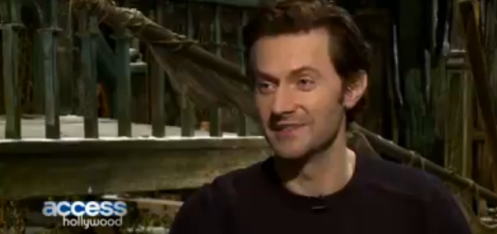
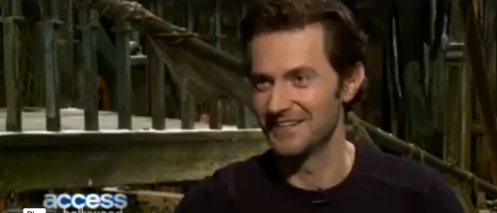
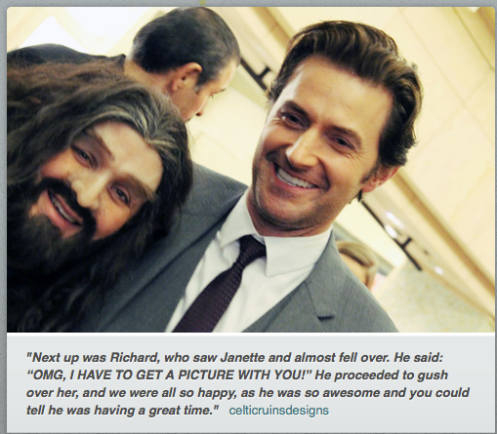

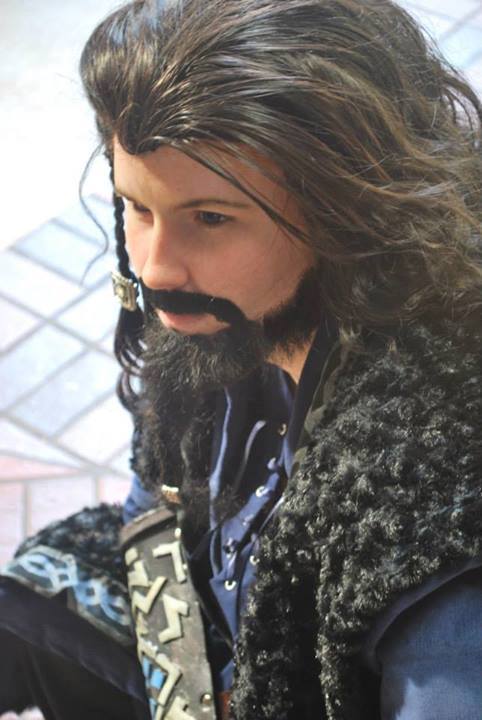
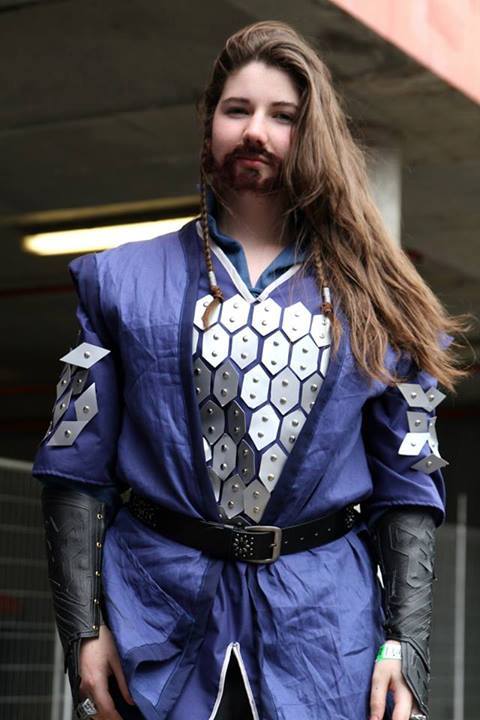

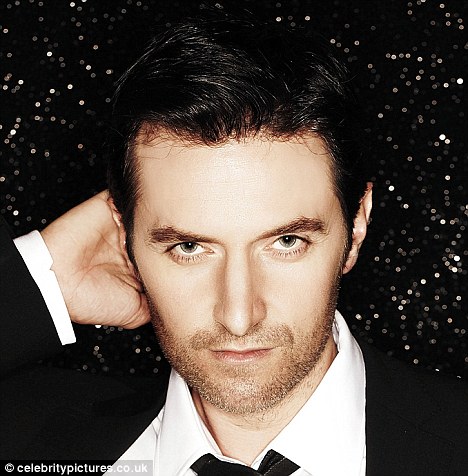

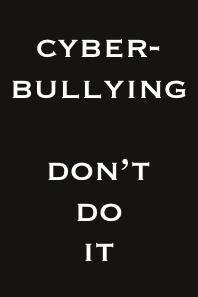
Note to self — what this post doesn’t address, and I’m not in a position to address, because I don’t really have the data right now, is why teenage or young women might cosplay Thorin. I complicated the issue by illustrating the post w/pictures of young women so I should probably think about that at some point at least. Does the heroic element play a more important role for them?
LikeLike
Fascinating! I have never cos played (except Halloween though that may be something completely different) and by the end of the the post I was thinking about that $800.00 Thorin armor on Esty in a whole new way.
Just wondering what someone who can easily relate to 1-7 should think, about how it all ends for Thorin? Should he be a cautionary tale?
LikeLike
I know at least one person who’s fairly worried 🙂
I found myself contemplating, last year, buying Thorin bracers. I then didn’t do it, but they were really tempting and I spent a couple of days wondering why. It was indeed something about the symbolic armor quality of the whole thing.
LikeLike
I don’t know anything about cosplay and can only speculate. I have said before that I am a very tall woman. I have heard “May I help you sir?” hundreds of times over the years. And that is with makeup, a tennis skirt and yes, prominent boobs.. Needless to say, it’s a bit embarrassing/disheartening. I would never try to look like Thorin or any other guy. Too easy. A challenge would be a princess/elf maiden. I am oversimplifying the Thorin cross dressing issue, but could one of the reasons be because these women are dwarf sized with long hair and if they add a beard can really rock the look. I would like to know if women cosplay other hunky fictional heroes. Do they dress as Thor or Loki? I have no idea but I would like to know for the sake of comparison and if Thorin ladies are unique to cosplay. Are there female Capt. Kirks or Luke Sky walkers? Very interesting topic, it would be great to hear from a Thorin player. I hope one turns up
LikeLike
I think that’s a reasonable suspicion — that it’s a strong possibility for shorter women. One aspect of cosplay is supposed to be the charm of getting it right, creatively.
re: Loki, the answer seems to be yes.
LikeLike
I woul love to dress as Loki :)..but after these holidays my only option is Thorin…I don’t need that fat-suit anymore 😉
LikeLike
LOL. I’m sure it’s not that bad.
LikeLike
I agree with your assertion of women cosplaying Thorin because they relate to him. I don’t think anyone might cosplay as Tauriel. Then there’s this thing I saw on Tumblr about women cosplaying Captain America. So I think cosplaying male characters might make them feel strong and better about themselves.
LikeLike
well, one of the cosplayers in that pic above is a woman cosplaying Tauriel … so it apparently appeals to some women ….
but I can see the crossdressing aspect really has some appeal. One of my favorite images of Thorin from AUJ occurs when he bursts out of the bushes to attack the stone trolls, and if I could see myself in that sense, cosplaying Thorin would be really attractive.
LikeLike
Love this post! With regard to Richard and gender issues, I often sing-song “one of us, one of us” to my sister whenever Richard does something relatable to us, both as females and as geeks. Then there’s the way he performs, and how I haven’t seen him in a single role that hasn’t made me want to see him tied up and under the stiletto heel of my shoe (or someone else’s, I’m not picky). I haven’t seen him in Between the Sheets yet, but I’m guessing that one’s not going to change how I perceive him either, considering what I remember from your earlier post of it. And definitely the one thing I wasn’t expecting when I first watched AUJ was coming out of the theater thinking of Thorin as a hot sub, after decades of having this unaltered image in my head of Thorin being an ornery, ancient, beardy, all-around unpleasant Dwarf. Richard just does something to his characters that I respond to in a particular way that I don’t know how to verbalize.
My perceptions of Richard and his characters aside, I do think Richard the actor might have some pretty uncontested gender perceptions himself, which could (possibly?) adjust given different exposure.
I really like Tauriel, and I think her role is one of the few instances where I don’t mind the lack of character flaws, mostly ’cause of the limited room for Peter/Fran/Phil to move around in as storytellers in this particular world. I personally think they struck a pretty fine balance with her, but I can see why others might not like her.
Cosplay! The topic got me excited. 😀 Genderswapped cosplay is a thing, and a lot of men and women do it really well. But even if they don’t, I think cosplay is similar to other forms of fan expression, ie they love this character a whole lot and want to show their love of him/her with fellow fans. It’s mostly the professional or serious cosplayers who ask an added “will this character fit me/my body shape/my face, and how can I adjust things accordingly” to themselves. I love your hypothesis on why women choose to cosplay as Thorin (particularly number 5!). Sadly, cosplay also sometimes has a somewhat misogynistic bend in its fan culture, though it has more to do with social stigma and the perception that nerd culture is, and should be, dominantly male. Cosplayers are also often perceived as being a little out of touch with reality, mostly by those who don’t get why people would even want to cosplay in the first place.
Genderswapping in general (or Rule 63) is something that I really love in fandom–and I really, really love that a lot of fanfic writers and readers of The Hobbit have been expanding their headcanons of Dwarf culture to allow for fluid sexuality (I love that Evangeline pointed out the bearded Dwarf ladies as an easy bridge for cross-gender experimentation). It’s a little shocking sometimes to hear stricter gender views from others after living in certain fan bubbles.
Anyway, love this post, hope you don’t mind if I link it to a few friends. ❤
LikeLike
Oops, link didn’t show, sorry! Re: the part about people thinking cosplayers are out of touch with reality:
http://geek-news.mtv.com/2013/08/06/heroes-of-cosplay-cosplayer-reax/
LikeLike
“Richard just does something to his characters that I respond to in a particular way that I don’t know how to verbalize.” — yes. and I’ve spent thousands of words trying to verbalize it myself … lol. I wish words would bring me closer. In thinking about this, I always go back to a very early comment I got in 2010 when someone was querying why we ask ourselves “is he for real” and relating that to patterns of female gender identification — i.e., this is a question we ask ourselves about ourselves because we’re called upon to be so role flexible in heterosexual patriarchy …
I’m reading this interesting book called Fic: Why Fanfiction is Taking Over the World — it addresses some of these gender questions as well.
LikeLike
I’m FB friends with a young woman who loves cosplaying female characters, and she’s made herself a terrific Tauriel costume. To me, it seems that her cosplaying is about asserting her female identity — she would never, ever want to play a male dwarf (or even a female one, given the whole beard thing). So, although I know that’s not what you’re focusing on here, I just want to say that not all females want to cosplay male characters.
It’s my impression that since AUJ came out, the male Hobbit cast has had to come to terms with the number of females cosplaying their roles. I don’t think they were prepared for it. But they probably weren’t prepared for the level of fan involvement, anyway.
The internet has made it so much easier for fans to express themselves creatively in a variety of ways, whether it’s through fan art, fan vids, fan fiction, cosplay, knitted or crocheted representations of the characters, or whatever it may be. That means that the actors, who probably think of themselves as the “owners” and creators of those characters, all of a sudden are faced with myriad interpretations of their own work. I think that could be unsettling, especially if an actor is used to protecting the character, and defining, during the filming process, what he (or she) would or would not do. So letting go, and letting fans create their own, modified versions of the characters, could be a challenge for an actor at first.
So I think that the attitude of the Hobbit cast has evolved — and I wonder if that’s actually the case. Are the clips and comments you’ve shown above in chronological order? Did Richard start by saying, “It’s weird,” but now he’s pleased to see women in beards? I wonder.
LikeLike
yeah, I wouldn’t want to be understood to have said that women don’t want to cosplay female characters. I’m not even saying that about myself — I can imagine there might be female characters I’d cosplay — just that I’d never cosplay Tauriel. I’m only speculating on why women between 30 and 50 might find Thorin an attractive cosplay possibility and thus, why the fact that they have to gender bend in a way that men (including their idol) could find unattractive would not be an obstacle.
Nice point about the question of “possession” of a character (although, frankly, those characters are a lot older than the actors who play them and my RL FB is filled with comments by people who are critical of how the actors “created” the characters). Agree that despite forewarning they were not prepared for the fans’ level of enthusiasm.
I put the comments above in chronological order. So, yes, Armitage’s comment that “it’s really scary” is one of the more recent ones. Although the sequence of the final two interviews is not entirely clear to me; I think the comment about the Army precedes the Cinemax interview, but I posted them in the order they were published. In any case, the statements to fans and the asking to be photographed with fans cosplaying Thorin suggest that his attitude is complex and probably contingent on the moment in which he’s being asked to respond.
LikeLike
Hmm, that’s interesting. I guess it makes sense that in some ways he’d still be making up his mind about how he felt about it. The evidence of fan enthusiasm has to be gratifying, but maybe he’s still not used to seeing the women in beards.
I’m not sure why some women would find Thorin an attractive cosplay character, but recently I’ve been thinking about ways that women don’t let themselves feel or experience anger, rage, or other “negative” emotions — but men can feel those things and act on them. So in some relationships, the man becomes the keeper and expresser of those feelings, to the detriment of both parties.
So maybe there’s something freeing about being fierce and belligerent, while still being recognizably beautiful on some levels.
LikeLike
I suppose the unasked / unanswered question is how he feels about women in Thorin cosplay gear vs men in the same gear. I also wonder if there are more female Thorin cosplayers? In a way, the fact that Thorin is so diminutive might make him less attractive for a man?
I definitely think female viewers identify with Armitage’s expressions of emotion through various characters. Or anyway, I do 🙂
LikeLike
Serv, I’ve never contemplated the cos-play aspect of why women identify with Thorin, so thank you for your thoughts and looking into it. However, you put into words almost precisely why we identify with Thorin as a character, and in particular, the film version of him. Brava to you, lady!
LikeLike
potetntially anyway. Thanks, boudicca61!
LikeLike
The cosplay, or dressing as Thorin made me think of the recurring motif of some older stories where a woman cuts her hair, dresses as a man and joins the army *to have an adventure* (generally 19th century or earlier). As Eowyn does in LOTR. I wonder if Mr Jung would have something to say about female Thorin cosplayers finding space to explore their inner masculine/animus, which is not the same as cosplaying a strong female/anima character. I guess this expands on Saraleee’s comment above, about the perceived freedom of being able to express a *masculine* fierceness and belligerence. Or it could just be fun and creative! I find both lines of thought interesting.
LikeLike
Ooooh, NICE point about Jung. You always remind me of that and I always remind myself to think about it some more and never do, but it’s a great thought.
People could be doing it for all kinds of reasons, of course.
LikeLike
[…] question from reporter and Armitage responds in kind. Why do fans cosplay Thorin, Mr. Armitage? We talked about it last year. […]
LikeLike
Richard Armitage interviewed last night: And this was the guy who asked for beard suggestions? | Me + Richard Armitage said this on December 10, 2014 at 3:09 pm |
When I was about five my best friends were two boys the same age (one of which had a silver filling smack dab in the middle front of his front tooth which I greatly admired and I was determined to marry him when I grew up). Anyways, Batman with Adam West was on TV and was my favourite show (of all time). My two little friends and I spent one summer tying beach towels around our necks for capes to play Batman and Robin. Well, my two male friends would insist I be ‘Robin’ because I guess in their eyes Robin was girly, that he was inferior to Batman and since I was the girl, I was inferior to them because they were boys and therefore it was their right to be Batman, to be top dog. I would have none of that….Batman was the hero and Batman was my hero and my favourite character on the show…so Batman I was whether they liked it or not. So there were 3 Batmans running around (sorry Robin). I think females dress as Thorin because I don’t think male or female comes into it at that level…simply the fact that Thorin is their favourite, their hero, the one they want to emulate. And on weekends when not dressing for work I love to wear buffalo plaid flannel men’s shirts…not because I want to be or look butch or something…I just really like them! I don’t know why some people take it to heart if RA makes a comment that ‘beards aren’t a good look on a woman’ or he ‘doesn’t want to be the fat guy’. Geez, he’s only human, he’s not a saint. No offence was intended and it doesn’t mean he hates fat people…he likes to be in shape, that is what he wants to be…it doesn’t mean anything other than that. And if a woman has a beard, maybe he prefers her to shave…after all, we all certainly comment as to our preference of him bearded or shaved!
LikeLike
Oh, and Ros Myers is a favourite of mine as well. She kicks butt. She’s calm, cool and professional. And she has some pretty snappy lines…I liked her little bits of humour.
LikeLike
Ros Myers is a favorite of a lot of ours, precisely because she feels free to explode gender stereotypes. See: https://meandrichard.wordpress.com/2010/04/09/collateral-attractions-hermione-norris/
In contrast, saying “women shouldn’t have beards” reinforces gender stereotypes.
LikeLike
The point of this post was (a) to point out how varied his statements around the beard have been and (b) to point out exactly how wearing a beard is not about being a woman. The post explores exactly what you’re talking about — women who don’t want to be plugged into a particular role as women. And that’s what’s wrong with his statement — because when those women are there wearing beards and dressing as Thorin, they are not there as women. They are there as Thorins. They don’t exist to be the object of his or anyone else’s male gaze, to be attractive or unattractive. They want to be the best Thorin they can be. And when he says women with beards are creepy, he’s saying partout that women can’t be fully adequate Thorins. Morevoer, when he says that, he objectifies people who are making a statement about their desire to be seen outside of the realm of objectification. The difference to saying “I prefer Richard Armitage wear a beard or not a beard” is that I’m not saying “it’s creepy if he doesn’t have one,” i.e., if he lacks one of the characteristic secondary sex characteristics of a man. I’m not questioning his solidity in his gender when I make that statements.
He is certainly entitled to any opinion he has about female cosplay of Thorin, including that features of it are creepy. He is also entitled to express those opinions to the press although I think that’s at the least a poor political choice on his part.
LikeLike
OK, now I see what you are saying regarding his statements…I didn’t fully comprehend the context before…I don’t think things through that far…that is why I am following your blog. It makes me think about things on a deeper level as I tend to not dig below the surface and really give things serious enough consideration.
LikeLike
you don’t have to agree with me! I only argue with people who I think can take it.
I think there’s a problem if we start applying human gender stereotypes to dwarves — although I understand the inclination to do so. One reason women like to cosplay Thorin, I suspect, is that he breaks a lot of human gender stereotypes. In particular, he takes care of his hair 🙂
LikeLike